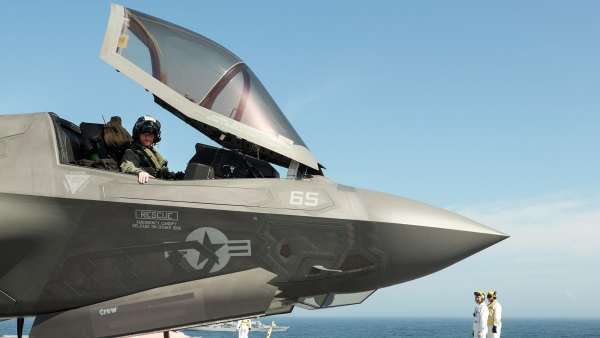It takes just one low fly-by to realise that fighter jets are straight-up the coolest things on the planet.
At around $100 million per plane, Lockheed Martin’s Joint Strike Fighter is, arguably, the most complex weapon ever created: capable of clocking 1,930km/h, tracking ballistic missiles from 1,300 kilometres away, and making a sound that’ll have you fist pumping like Tom Cruise on a motorcycle.
While the machine is no doubt a masterpiece, it’s the F-35 fighter jet helmet that really deserves a special look. It’s so advanced that it’s hard to say whether it’s an accessory for the plane, or the plane is an accessory for the helmet.
Either way, the Rockwell Collins and Elbit Systems-engineered kit is designed to make the F-35 an extension of the pilot’s body.
Gone are the days of helmets being just protective shells. Each F-35 fighter jet helmet is built around a custom-fitted insert based on a 3D scan of the pilot’s head and combines noise-cancelling headphones, night vision, a forehead-mounted computer and a projector.
Weighing in at 2.3 kilograms, it’s surprisingly light for the amount of gear it’s packing, though it’s important to bear in mind that weight can increase tenfold when subject to the incredible G-forces experienced in flight.

With the amount of data being conveyed, Bluetooth and Wi-Fi aren’t quick enough so the helmet is connected via a thick strand of Kevlar-sheathed cords. When tethered in, pilots are granted the visual capabilities of Superman and then some. The pilot can literally see through the base and walls of the aircraft thanks to six cameras mounted on the outside of the plane and projected into the fighter jet helmet.
This “Distributed Aperture System” provides a 360-degree view of the plane’s surroundings by stitching together video feeds based on where the pilot is looking. Mental.
No longer does Maverick need to grind endlessly to get a lock on, either, as all pilots have to do in the F-35 is look at an object and then flip a switch to unload some lead. While this is happening, the jet’s sensors are constantly looking for approaching threats and keeping track of wingmen, projecting info on the pilot’s visor. Because the F-35 is constantly communicating with its peers, pilots are able to tap into other plane’s feeds to see what they are targeting, too.
One of the aircraft’s greatest strengths lies not in its ability to wipe targets off the face of the Earth, but rather in its information-sharing systems. The F-35 provides a unique integrated air combat capability that allows allied F-35s to support each other, despite being from different nations, with information being shared continuously.
This connectivity ability benefits not only the F-35 but other weapons – it has the ability to coordinate fleets of unmanned combat aircraft and guide weapons launched from other platforms, such as warships.
The US military’s program to acquire the F-35 has had its teething issues, with the budget allocated to Lockheed Martin blowing out from $233 billion to $379 billion to date and being four years behind schedule on deliveries. The entire program is forecast to cost $2.10 trillion over its 55-year lifecycle.
Check out the video below for some highly pleasurable fighter jet footage courtesy of the French Navy in their Dassault Rafale planes.
RELATED: 13 Best Motorcycle Helmets In 2023 [Brand & Safety Guide]
